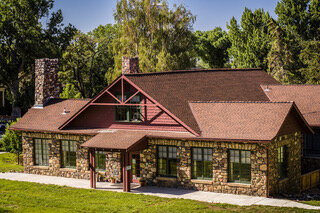Sharing a story I recently read about the Greenville Indian School that occurred in December 1916 that shows why sugarcoating the history of these schools, especially as they were run during the early decades of the twentieth century, is dishonest and disgusting.
Read MoreLife at Native American boarding schools in the early twentieth century was highly regimented; bureaucrats from the Department of the Interior sought to manage every last aspect of student life. A few years ago I found a huge book of “circulars,” similar to memos, in the National Archives in Washington, D.C., that captures how strictly the daily lives of students and employees were managed. Some of the contents of these documents made it into my book on the Stewart Indian School. Many that did not are still worth writing about, though, if only because they represent the intense control and negligence of federal officials overseeing the Native American boarding school system.
Read MoreOn May 11, 2022, the Department of the Interior released the first volume of a comprehensive report on the history of Native American boarding schools in the United States. As outlined in a June 2021 memo on the Federal Boarding School Initiative (link), this first volume sought to identify all boarding schools that operated in the U.S., create an official list of federal records connected with federally-managed boarding schools, and find evidence of unmarked burial sites at these facilities. The report was prepared under the leadership of Assistant Secretary for Indian Affairs Bryan Newland.
Read MoreThis post explores a series of events that investigated by the Office of Indian Affairs in 1903 at the Fort Lewis Indian School in Colorado. This case illustrates how investigations were organized at the turn of the 20th century, how feedback from Indigenous and other external sources factored in, and how the OIA responded to accusations against boarding school personnel.
Read MoreOne June 22, 2021, Interior Secretary Deb Haaland, a member of the Pueblo of Laguna, issued a memorandum creating the Federal Indian Boarding School Truth Initiative. This new initiative is the first formal federal investigation into the boarding school system in the U.S., and was prompted by the discovery of 215 unmarked graves at the Kamloops Indian Residential School in British Columbia, Canada.
Read MoreIn January 2020, the Stewart Indian School Cultural Center & Museum opened in Carson City, Nevada. Since the boarding school’s closure in 1980, former students and their families had urged the state of Nevada to commemorate alumni experiences as a means of recognizing their trauma and need for healing. After decades of Indigenous advocacy, the Stewart Indian School Cultural Center & Museum addresses these concerns and shares the history of the school through the voices and perspectives of boarding school survivors. To underscore the importance of this approach, Stewart Indian School alumna Linda Eben Jones’ reflections of her time at the school and her evaluation of the museum are integrated throughout this essay.
Read MoreAs I finish the final revisions for my book on the history of the Stewart Indian School, I am sharing my experiences with academic publishing with anyone else for whom this information might be useful. This is the second of three posts (see my first post here), and focuses on what you can expect from the peer review, author response, and contract process. Enjoy!
Read MoreI am in the midst of final revisions for my book on the Stewart Indian School, and have learned a lot over the course of the academic proposal-editing-publication process. This being my first go around, I initially had no idea what to expect or even what questions to ask. Now that I know I little more, I figured I would share my experiences to help other publishing newbies. This first of three posts focuses on preparing a book proposal. Enjoy!
Read MoreWe know students who attended Native American boarding schools experienced various types of violence at these institutions. What may be less well known is that students were also the subjects of medical research and experiments conducted without their (or their parents’) consent. Why did this happen? How are instances of medical experimentation on Native boarding school students connected with the broader history of medical experimentation on people of color in the United States? This post explores these issues.
Read MoreTo what extent did employees at Native American boarding schools use violence against students and their parents? Was violence a rare or common occurrence? Was it more likely during the early years these schools were open? This post answers these questions and explores others related to this difficult, but important topic.
Read MoreWhat was vocational training like at Native American boarding schools? What types of training did students receive and why? And how was vocational training connected with the assimilationist mission of boarding schools?
Read MoreLike many others, I have had to reimagine my workday and workflow to accommodate our new realities. Here are some tips that have helped me keep writing since March.
Read MoreWhat was the role of religion in Native American boarding schools? Why did federal officials connect the assimilation of Indigenous children with their acceptance and practice of Christianity? Did reform efforts in the 1930s and 1970s change how schools incorporated Christian instruction into their curriculum?
Read MoreIn September 1908, Allie Helena Barnett left her family in Atchison, Kansas, and traveled to Carson City, Nevada, where she had accepted a job as a nurse at the Stewart Indian School. Barnett, an African American woman, had graduated from nursing school at Provident Hospital in Chicago in 1906. At the Stewart Indian School, she found secure employment taking care of Native American children and teaching them about health and hygiene. Barnett excelled in her position and received glowing evaluations from her supervisors during the nine years she worked at the school. However, though Barnett was widely praised for her talents, school officials could not reconcile Barnett’s abilities with her race. After all, boarding schools like Stewart were founded on the white supremacist idea that Native Americans would become extinct if they did not reject their supposedly inferior cultures and accept that of white Americans.
Read MoreHow many Native American boarding schools were there across the U.S.? Are all of them closed? How many Native children attended these institutions? Looking at the Native American boarding school system from the macro level underscores how widespread this system was, and just how many Native families it impacted.
Read MoreWhat was life like for Stewart Indian School students during the postwar period? Last week I wrote about student life at the Stewart Indian School between 1890, when the school opened, and 1945. This week, part two focuses on the postwar years through the closure of the school in 1980s.
Read MoreWhat was a typical school day like for students who attended the Stewart Indian School? The answer depends on a number of factors. Students who attended in the 1890s and early 1900s were subjected to a highly regimented, strictly assimilationist environment, whereas students who attended in the 1970s had much more freedom to express themselves and explore their Indigenous identities. National politics are another important factor: the 1934 passage of the Indian New Deal changed many aspects of student life at Stewart, as did the termination and relocation laws of the 1950s. And the presence of abusive employees or protective older students further impacted children’s experiences at Stewart. This post explores how daily life changed between 1890 and the end of World War II.
Read MoreMy latest article was published on nursingclio.org. To read the entire piece follow the link below.
https://nursingclio.org/2020/04/02/training-future-wives-and-mothers-vocational-education-and-assimilation-at-the-stewart-indian-school/
Read MoreIs it possible to think about anything other than illnesses and epidemics right now? When I was trying to decide what to write about this week, it seemed logical to explore these issues at the Stewart Indian School, especially because disease outbreaks were so common there (and at other off-reservation boarding schools) until the 1920s and 1930s.
Read MoreThis post is a short one – I figured I would share some boarding school reading material for anyone with a little extra time and an interest in this history.
Read More


















